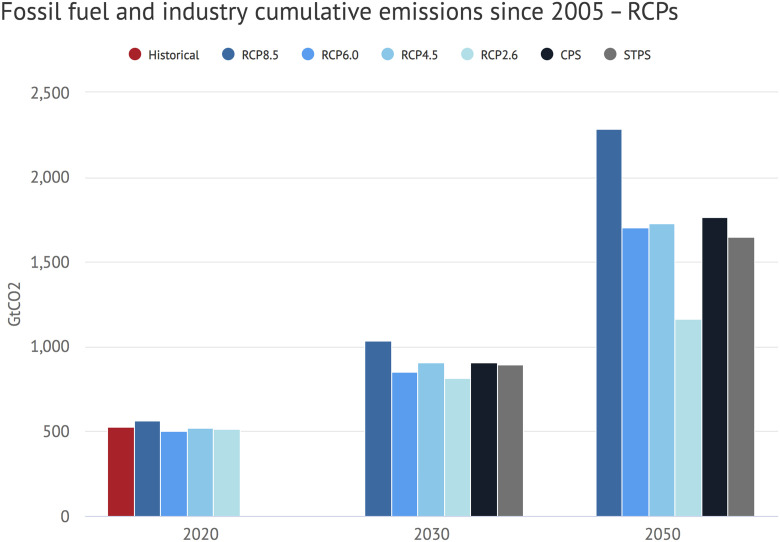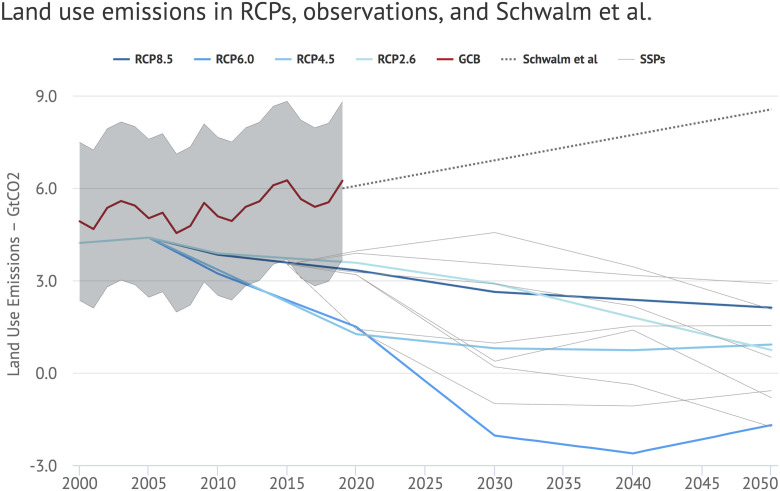Schwalm et al. (1) argue that both historical and near-term (through 2050) cumulative emissions are more in line with Representative Concentration Pathway 8.5 (RCP8.5) than other RCPs (2), and take issue with our suggestion (3) that the treatment of the scenario as “business as usual” is misleading.
We previously pointed out (3) that International Energy Agency (IEA) World Energy Outlook (WEO) scenarios (4) of near-term fossil CO2 emissions are a more reliable indicator of likely outcomes under current policies than RCP or Shared Socioeconomic Pathways (SSPs) (5) baseline scenarios, as they account for the global decline in coal use over the past decade and falling prices of clean energy technologies. We found IEA scenarios agree much more closely with weak or modest mitigation scenarios like RCP6.0 or RCP4.5 than the high-end no-policy RCP8.5 scenario.
This conclusion holds when we replicate the Schwalm et al. approach, comparing IEA fossil CO2 cumulative emissions to those of the RCPs (Fig. 1), as well as when using either total or fossil emissions in the new SSPs (5). The IEA scenarios only provide fossil CO2 emissions; the results of Schwalm et al. thus rely solely on the nonfossil component: emissions from land use change (LUC).
Fig. 1.
Data from ref. 1. The red bar shows historical fossil emissions (5), the blue bars show RCPs, and the black and gray bars show IEA (4) current policies (CPS) and stated policies (STPS) scenarios.
Two factors drive differences between RCP and Schwalm et al. land use emissions assumptions. First, RCPs all have notably lower land use emissions (1.5 to 3.6 GtCO2) than current best estimates from the Global Carbon Project (GCP) (5.5 ± 2.6 GtCO2) (6). The RCPs were based on earlier versions of the GCP LUC emissions, which are lower than those published today. Second, all RCPs and SSPs—even high-emission baseline scenarios—project land use emissions will decline, while Schwalm et al. assume a linear increase based on past 15-y trends (Fig. 2).
Fig. 2.
Historical LUC emissions (red line) with uncertainties (gray shading) (5), RCP (blue lines), and Schwalm et al. linear projection based on the 2005–2019 trend (dashed black line). The SSPs (gray lines) also mostly project future declines in LUC through 2050.
The GCP (6) points out there is “no consensus in the mean and trend in land use change emissions over the last decade,” and extrapolating the past 15 y forward for the next 30 is not a particularly defensible assumption. This disagreement indicates the importance of reducing uncertainty in both current and future LUC emissions.
Future emissions in both the RCPs and SSPs are dominated by fossil CO2 in baseline scenarios, and we have strong evidence that both near-term and long-term fossil CO2 emissions are overestimated in emissions scenarios associated with 8.5 W/m2 forcing pathways.
The match to near-term cumulative emissions that Schwalm et al. find is due to compensating errors of too-high fossil CO2 emissions and too-low land use emissions. The extended IEA WEO scenarios (4) they develop include future land-use emissions assumptions at odds with emissions in both the RCPs and the new SSPs. The SSPs—which are being used by researchers going forward—show that the SSP4-6.0 and SSP2-4.5 scenarios agree much better with near-term cumulative emissions than the SSP5-8.5 scenario when using the Schwalm et al. approach.
Footnotes
The authors declare no competing interest.
References
- 1.Schwalm C. R., Glendon S., Duffy P. B., RCP8.5 tracks cumulative CO2 emissions. Proc. Natl. Acad. Sci. U.S.A. 117, 19656–19657 (2020). [DOI] [PMC free article] [PubMed] [Google Scholar]
- 2.Riahi K. et al., RCP 8.5—a scenario of comparatively high greenhouse gas emissions. Clim. Change 109, 33 (2011). [Google Scholar]
- 3.Hausfather Z., Peters G. P., Emissions—the “business as usual” story is misleading. Nature 577, 618–620 (2020). [DOI] [PubMed] [Google Scholar]
- 4.International Energy Agency , World Energy Outlook 2019, (International Energy Agency, 2019). [Google Scholar]
- 5.Riahi K. et al., The Shared Socioeconomic Pathways and their energy, land use, and greenhouse gas emissions implications: An overview. Glob. Environ. Change 42, 153–168 (2017). [Google Scholar]
- 6.Friedlingstein P. et al., Global carbon budget 2019. Earth Syst. Sci. Data 11, 1783–1838 (2019). [Google Scholar]




